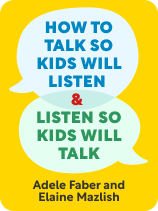

This article is an excerpt from the Shortform book guide to "How to Talk So Kids Will Listen & Listen So Kids Will Talk" by Adele Faber and Elaine Mazlish. Shortform has the world's best summaries and analyses of books you should be reading.
Like this article? Sign up for a free trial here.
Want to know how to talk so your kids will listen to you? What advice can you learn from the book How to Talk So Kids Will Listen & Listen So Kids Will Talk?
How to Talk So Kids Will Listen & Listen So Kids Will Talk helps you build mutually respectful relationships with your children. Written by two educators, Adele Faber and Elaine Mazlish, it’s been dubbed “the parenting bible” by The Boston Globe.
Read on to learn how to talk so your kids will listen, based on an overview of the book’s parenting advice.
How to Talk So Your Kids Will Listen
According to Adele Faber and Elaine Mazlish, the key to understanding how to talk so your kids will listen is teaching kids a communication style that will help them be empathetic and responsible throughout their lives. This style focuses on constructive solutions rather than blame, takes account of everyone’s needs and feelings, and expresses negative emotions without damaging relationships.
How to Talk So Kids Will Listen & Listen So Kids Will Talk by Adele Faber and Elaine Mazlish will help your family communicate more effectively. Making sure your children feel heard will encourage them to cooperate, lead to fewer arguments, and make your interactions less stressful and more enjoyable, according to the authors. Once you establish this virtuous cycle, it will pay off for years.
The method described in this book helps parents convey a key message to their children: “You’re a competent person, and I trust that you’ll do the right thing.”
Faber and Mazlish published their first book, Liberated Parents/Liberated Children, in 1974. Faber holds a master’s degree in education from NYU and taught in New York City high schools for eight years, while Mazlish was a director of children’s programs (Mazlish died in 2017). Each was the mother of three children.
Together, they studied with child psychologist Haim Ginott, who stressed the importance of accepting a child’s feelings. After their first book came out, Faber and Mazlish began leading communication workshops to address a key problem raised by readers: Parents didn’t want to use older, stricter forms of discipline that stressed parental authority, like telling their children, “Because I told you so.” However, they didn’t know alternative methods of parenting that stressed communication and empathy.
Parents found these workshops so helpful that Faber and Mazlish knew they had to put the advice into a book on communication, and so in 1980 they published How to Talk So Kids Will Listen & Listen So Kids Will Talk. The book was so popular that they quickly became internationally acclaimed experts. PBS produced a six-part series, and they received fan mail from parents around the world.
They wrote more books, including Siblings Without Rivalry (a #1 The New York Times best seller), How To Talk So Kids Can Learn—At Home and in School, and How To Talk So Teens Will Listen & Listen So Teens Will Talk. The latter includes more focused advice about dealing with adolescents, even though the original version is useful for parents of toddlers through teenagers—and even for adults who want to improve their skills at communicating with other adults. The authors were faculty members of The New School for Social Research in New York.
A Relaxed Approach to Parenting
In explaining how to talk so your kids will listen, Faber and Mazlish take an encouraging and relaxed approach that many parents find reassuring. They acknowledge that parenting is frustrating and advise parents to be patient with themselves as well as with their children. Faber and Mazlish say you shouldn’t worry if you don’t say the perfect thing every time—there will be plenty of other chances to use the skills you’ll learn in this book. The first step is noticing when you say things to your child that you don’t feel good about. Then you can work to communicate in more positive ways.
(Shortform note: This relaxed approach may seem unexceptional now, but in the 1970s, parents often disciplined more harshly, and spanking was more common–even in schools. Today’s readers might be surprised that Faber and Mazlish spend so much time discussing why spanking is not an effective punishment. The authors also seem ahead of their time in opposing “time-outs” for children; banishing a child, they argue, is punitive instead of helpful, and talking compassionately to your child about their behavior is always the best strategy.)
Because How to Talk So Kids Will Listen & Listen So Kids Will Talk was created from workshops, it introduces and discusses topics by using many exercises and Q&As. In contrast, this overview will focus on its five main ideas:
- How to deliver empowering praise
- How to respond to your child’s negative feelings
- How to encourage cooperation and independence
- How to challenge your own preconceived ideas about your children
- How to set limits and encourage desired behavior without punishment
| What’s Your Parenting Style? Many of Faber and Mazlish’s ideas have been incorporated into methods that are now known by other names. According to some researchers, there are four main styles of parenting—permissive, neglectful, authoritarian, and authoritative. The ideas in this book resemble the authoritative style. Permissive parents indulge their children to avoid conflict, while authoritarian parents go too far in the other direction and impose strict rules and punishment. Neglectful parents don’t provide much guidance or pay attention to their children’s needs. Authoritative parents, on the other hand, solve problems together with their children, communicate clearly, and set clear expectations—all skills encouraged by this book. Authoritative parenting arose in the 1960s, and it was then adapted into several other styles said to be more nurturing. In the 1980s, Dr. Jane Nelsen introduced the idea of “positive discipline,” and in the 2010s, Sarah Ockwell-Smith popularized the term “gentle parenting.” These styles are all very close to Faber and Mazlish’s approach. |
1. Deliver Empowering Praise
Faber and Mazlish explain that giving empowering praise is a great way to start effectively communicating with your children. They emphasize praise for several reasons. First, praising your child is something proactive that parents can do any time. It ensures you’re communicating not just about problems that need to be addressed, but also about what you’re proud of. Finally, it’s a powerful way to encourage positive behavior.
Use Descriptive Praise
The authors recommend descriptive praise, which means specifically and enthusiastically describing what you see in their drawing, such as the shapes and colors. Your children will appreciate that you’re paying attention. Descriptive praise also makes children aware of their strengths and builds their self-esteem. They can then praise themselves.
2. How to Respond to Negative Feelings
If you want to talk so your kids will listen but also show that you understand how your child is feeling, Faber and Mazlish stress that in addition to praise, a second key to communicating better with your child is to show that you understand, accept, and empathize with their feelings. Children, even babies, want adults to understand how they feel, especially when they feel unhappy.
Acknowledge a Child’s Feelings
Instead of dismissing or minimizing them, accept and acknowledge your child’s feelings. All feelings are O.K., even if all behaviors are not. You can say, “I can see you’re upset that your sister broke a crayon, “You’re mad at your brother,” or “So you’re still hungry, even though you just had lunch.” Echo your child’s feelings: For example, if your child is disappointed, express disappointment in your own voice. Faber and Mazlish explain that your empathy can calm your child, open them up to talking more, and give them the confidence to start solving their problem.
3. Give Autonomy, Get Cooperation in Return
A third pillar of Faber and Mazlish’s approach is giving your child a level of autonomy that’s developmentally appropriate. This will make them feel empowered in the relationship, create a smoother, give-and-take relationship, and make your child more cooperative.
Showing that you empathize with their feelings, described in the previous section, sets the stage for cooperation. To build on that, Faber and Mazlish suggest approaches that depersonalize the conflict so it’s no longer a war between you and your child but a cooperative endeavor instead.
Gaining children’s cooperation is key because parents have to stop their children from doing so many things—putting Barbie shoes up their nose, riding the dog—and this can make you seem like an enemy. When you get locked in a power struggle with your child, no one wins.
Faber and Mazlish recommend that you focus not on your authority but on solving the problem that needs solving. When you focus on solutions, your child may be able to suggest some creative approaches you haven’t thought of. By allowing them to come up with ways of addressing the problems they face, you’re also fostering their autonomy.
4. Challenge Preconceived Ideas About Your Children
According to the authors, a fourth key to effective communication is re-thinking any stereotypes you have, even unconsciously, about your children, and helping them resist the labels others may foist on them. The way you think about your children becomes the way they think about themselves. One of the authors describes how a nurse labeled her newborn son “stubborn” because he wouldn’t breathe right away. This label stuck, and it was hard for her to think of her child differently. The idea that he was stubborn became a self-fulfilling prophecy.
Don’t Stereotype Yourself
If you make a mistake, don’t call yourself “stupid” or “clumsy”; talk about what you can do better next time. Just as you would for a child, when you’re talking about yourself, address the behavior rather than the person. Model helpful responses to difficult situations. If you have to clean up a messy kitchen, admit to your child that you feel a little overwhelmed because it’s a big job, but then talk about how you’ll do it step by step.
5. How to Encourage Positive Behavior Without Punishment
Faber and Mazlish’s final principle is about how to use communication as an alternative to punishment. They explain that punishment is a distraction, because instead of reflecting on their behavior and how they can do better, a punished child becomes angry and upset and wants to take revenge. But many parents are at a loss for what else to do.
Ask Them to Help You Solve the Problem
Faber and Mazlish’s last point about how to talk so your kids will listen is about conflict resolution. They argue that it’s important to make your child part of the solution rather than making them feel like they’re the problem. This tactic echoes the earlier point about giving autonomy to get cooperation in return. The authors note that involving your child in brainstorming solutions (as previously recommended) can reassure them that you’re a team, and that you’re listening and taking their feelings into account. This approach isn’t about convincing your child that you know best, and they should do what you say. It’s about being open to solutions that your child suggests and trying to find a compromise.
Enlisting a child’s help in finding a solution draws on many of the skills Faber and Mazlish teach—giving reasons, giving choices, respecting your child’s feelings, encouraging autonomy, not giving your children negative labels.

———End of Preview———
Like what you just read? Read the rest of the world's best book summary and analysis of Adele Faber and Elaine Mazlish's "How to Talk So Kids Will Listen & Listen So Kids Will Talk" at Shortform.
Here's what you'll find in our full How to Talk So Kids Will Listen & Listen So Kids Will Talk summary:
- How to build mutually respectful relationships with your children
- How to make your children feel heard and understood
- Methods for effectively praising and scolding your children






